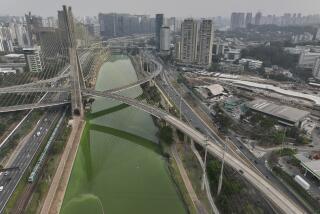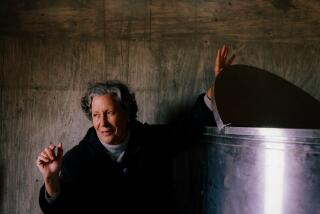Grapes Flourish in Barren Brazil Valley
JUAZEIRO, Brazil — In Brazil’s northeast, men have worked for generations to wring drops of water from the rain-starved soil. Now pioneers are turning the desert into wine, growing grapes in the Sao Francisco Valley that runs through the semiarid “sertao” region.
“We’re still some way from being the new California,” said Japanese farmer Suemi Koshyama, whose 500-acre farm near Juazeiro produces 400,000 boxes of export-quality grapes a year. “But we’ve certainly opened up new horizons.”
Brazil’s sertao, an area the size of France and Portugal that covers some five states where rainfall rarely exceeds 16 inches a year, has defeated millions of northeasterners over the decades. Its dryness has created a land with little electricity or water but an abundance of bandits, a place where whole villages have abandoned their small holdings to the cactus and emigrated to southern cities or the thick, mosquito-infested rain forests of the Amazon.
But now it is the very harshness of the climate, combined with massive government-sponsored irrigation projects, that is making the Sao Francisco Valley bloom.
“The soil is good. You’ve got 12 months of sun a year. All you need is water,” said Francisco Jose Pinto, planning director of the Juazeiro branch of the state-run Companhia de Desenvolvimento do Vale do Sao Francisco, which has been developing the valley since 1974. In fact, irrigation has been so successful that Pinto is betting his own small fortune on a plot of land and the mangoes he hopes to export at out-of-season prices to Europe and Japan.
*
Grapes were introduced in 1985. Eleven years later, the area around Juazeiro, a bustling riverside boomtown on the border of Bahia and Pernambuco states, produces more than 1 million boxes of high-quality grapes a year, most for export.
Europe is a natural market because the valley’s proximity to the equator allows harvests to be timed for the European winter. Five grape crops can be harvested every two years.
The state-run development company’s Juazeiro secretariat--one of six spread along the 1,680-mile Sao Francisco river--has irrigated 47,000 acres, creating a livelihood for 1.5 million people where before there was little but dust.
Pinto beams when he thinks of the possibilities. He says a 37-acre plot can net $67,000 a year on mangoes, a tidy sum for northeasterners used to earning less than $100 a month. But it was not always like that.
At first, the state-run development company’s aim was to provide economic help for the region’s dirt-poor subsistence farmers. “We would loan colonists money and it didn’t work. The first thing they did was buy a car, a television and a fridge. Then they would pay somebody to work the land for them,” Pinto said.
Now the state-run development company courts other companies. Its mission is to “educate” northeasterners into thinking like entrepreneurs and not subsistence farmers. It demands a business plan and allows the land to be used only in a profitable way.
“No more tomatoes, no more onions just because your father and your father’s father grew them,” Pinto said.
The most successful farmers are from outside, like Koshyama, whose parents emigrated to Sao Paulo when he was 5.
Beyond the lush irrigated spreads on the banks of the Sao Francisco, life in the sertao continues as it always has, stuck more in the 16th century than the 19th. Armed robbers lurk by huge potholes on the road from the Bahian capital Salvador to Juazeiro. Vultures circle over dead cattle while dust storms rage across the desert terrain.
There are few jobs. Women and children throw dirt into crevasses in the road, screaming for money from passing trucks and cars. They make a few dollars a day, enough to survive.
It is roads like these that pose the greatest problems for entrepreneurs like Koshyama. By the time his grapes reach Salvador, most have been pounded into juice.
Bahia’s state government knows it has a lot to do to help the would-be “Brazilian California” really take off and to lift the 12 million Bahians out of poverty.
For Bahia Gov. Paulo Ganem Souto, lounging in a cool Atlantic breeze blowing through his colonial mansion in Salvador during a recent interview, the solution is more federal government irrigation projects to take water beyond the narrow strip of green along the Sao Francisco. Bahia, one of Brazil’s poorest states, does not have the money, he said.
More to Read
Sign up for Essential California
The most important California stories and recommendations in your inbox every morning.
You may occasionally receive promotional content from the Los Angeles Times.










